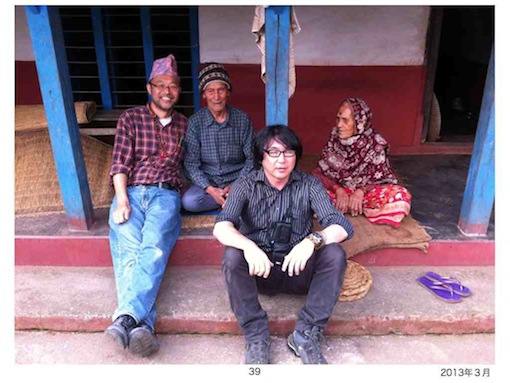Mitzub'ixi Quq Chi'j
The stories that I will
present to you today were collected from my fieldwork experiences among
Mam language-speaking Mayan indigenous people in San Marcos department,
Guatemala. I call the town where I conducted fieldwork Txolnimtze' (literally meaning
“among many trees”) which is a pseudonym. In my paper, I have described
several examples of local political issues among people. Unfortunately,
today I cannot present them all.
In the town of Txolnimtze' ,
even though all most everyone is bilingual, speaking Mam and Spanish,
they are not conscious of their bilingual abilities, “bilingualismo” in
Spanish, because of misunderstood propaganda reflecting central
government language politics. The government says to be bilingual is
using two languages, Spanish and English, not Spanish and an indigenous
language. But in the local context it can be said, historically, this
definition of bilingualism expresses national language politics because
the government wants to educate indigenous people who can speak Spanish
for assimilation into one nation.
In Txolnimtze', many local
teachers of elementary schools are native and bilingual. They can teach
in Mam, but they are required to teach in Spanish in their classrooms
under the direction of the Ministry of Education, MINEDUC, except for
teaching Mam language classes for only one or two hours per week. Even
though there exists this kind of adversity, Mayan indigenous people
maintain their own language. Native language competency is key factor
for surviving inside of indigenous communities because their mother
tongue provokes their primordial attachment, which as Geertz said, “is
meant one that stems from the ‘givens’-- or, more precisely, as culture
is inevitably involved in such matters, the assumed ‘givens’-- of
social existence” (Geertz 1973:259).
Sophisticated language usage is not good for being respected
culturally, but it is a necessary for defining one’s social
positionality in the town. We can analyze various aspects of language
usages not only from a cultural point of view, but also from political
points of view as the following polarizing topics.
(a) Monolingual versus Bilingual
In Txolnimtze' town, there
are a few ladino families. Ladino means semantically mestizo people,
“mixed blood of native Indians and Spanish conquers,” and
etymologically Latin people, “latīnus” in Latin. Ladinos are
traditionally monolingual. They have a typical identity of “not to be
Indian people.” Historically, the racial stereotype has been that
ladino might be acculturated Indians, meaning that all the ladino were
Indians who had came to town and abandoned their own Maya culture.
Apart from this fact, a few ladino people can speak Mam for maintaining
relationships with Indians through their commercial activities. In
fact, there is so much bilingualism in the town that there is a
polysemic saying, “to be people of the town (Xjal te Txolnimtze') ,” “to be
Mam,” “to be Maya,” and “to be Indian.”
(b) Catholic Action Catechists versus Maya Priests
The Catholic Action
(Acción Católica, AC) originated from the fundamental innovative reform
movement inside the Catholic Church in the 1960s after the period of
the failure of the Guatemalan revolution from 1945-1954. The political
connotation of Acción Católica means protecting devotees from communist
political activities and calling attention to authentic Roman
Catholicreligious life from folk Catholicism typical in Indian towns.
In Txolnimtze' town, there was a strong ladino priest who had
established the first normal school for young people and also organized
Acción Católica catechist groups for devotee townsmen. The priest used
native translators to translate from Spanish to Mam during mass,
expelled traditional Mayan priests (“chimanes”) from the church, and
prohibited performing traditional Mayan ritual inside the town. The
priest’s ambitions were to transform the town from being monolingual
Mam to monolingual Spanish. Native catechists used to use Spanish
written in the bible even in monolingual villages. In the church, this
priest established an FM radio station broadcasting bilingual programs
for native devotees. But Mam language usage in church is not more
sophisticated than in traditional Mayan ritual contexts because the
former is pragmatically translated from Spanish and the latter’s usages
always comes from the native way of life. Borrowing Basil Bernstein’s
language use concepts, the former can only have restricted code, while
the latter can have both restricted code and elaborated code (Bernstein
2003[1971]). Mayan priests are good at traditional usage and have rich
vocabularies in both the secular and paramount worlds. In general,
secular catechist’s usage of Mam tends to simplify on one side, the
esoteric Mayan priest’s usage tends to complicate on the other.
(c) High Academic Achievement Professionals versus General Townsfolk
As Kymlicka (2001:218)
wrote, “democratic politics is politics in the vernacular.” When I
first attended a town meeting of open dialogue among a dozen of mayor
candidates in 2007, all the candidates spoken in Mam, but their
competencies were variable in Spanish. Because of the deficiency of
political neologisms in Mam, we could hear many Spanish borrowed
technical terms of modern politics in their Mam speeches. Nevertheless
speech competency in their native tongue was very important. There were
some young political candidates who had graduated from university,
“licenciado” and civil engineer graduated at university or collage,
“ingenieros.” Professionalism ideology had just reached in this town.
Meritocracy had also just recently become familiar to almost townsfolk.
The art of speech in public spaces became one important competency for
mayoral candidates. This new type of leadership is now triumphing over
traditional nepotism and/or clientelism politics even though people are
familiar with conventional favoritism and/or patron-client relations.
In my original draft, I have discussed the conflictive political
situation relating with their speech acts – performative aspect of
language use – by describing portraits of people of Txolnimtze'. I
demonstrated how local people think about what is political autonomy
under the decentralization condition at the national level by
describing an example of a minor local conflictive debate between
town’s mayor fraction and the rebellious local council fraction. Today,
I will summarize my thesis in the following two points.
1. Within the Guatemalan nation, including the indigenous community,
the idea and legislation of decentralization policy has escalated from
the end of 1996 when the Peace Accord between the Guatemalan National
Revolutionary Unity (URNG) and the Guatemalan government was signed.
2. Generally speaking,
both transparency of voting system and the central government’s
decentralization policy can be seen as a kind of old liberal policy,
not a neoliberal one. We can find this type of policy in the John
Williamson’s (2003) Washington Consensus package that has been
criticized by old liberal students.
Through my fieldwork experience, I have identified conflicts from
factions pursuing hegemony under the political conditions after
decentralization of the political system and “democracy from below” in
municipalities. On one hand, the traditionalists use nepotism and
clientism tendencies to pursue hegemony. On the other hand, the locals
use bottom-up pressure to subvert hegemony. Some people have succeeded
being supported by townsmen through presenting their own discourse,
saying emotionally, for example, “Do not dispose easily and cheaply our
‘communal property’ to private and/or outsider agencies.” This type of
speech-act was articulated in a very sophisticated form in their mother
tongue, Mam language.
To become real “Mam” inside the town is completely different from the
presentation of self to outside agencies both inside and outside the
town. To examine this, I focused on the political activity and
discourses of a new type of political leader I call Carlos. I do not
evaluate his political ability and anticipate that he will be good
“Mam” politician. But instead, my analysis found that he has the
potential to be a new type of political leader in future in three modes
of ideal types; Homo modernus, the modern human being, Homo chronus,
the chronological human being, and Homo politicus , the political human
being.
As Homo modernus, Carlos has at least three faces of modern “Mam”; a
teacher of elementary school in the village, a leader of a traditional
dance group of local teachers, and “Aj Q’i’j” (literally translated, as
Counting Day shaman/priest). He was born as the son of a local merchant
and graduated from the normal school founded by the priest of Acción
Católica. He recounted his personal experience in his younger days
saying, “It’s sad to see the disappearance of our traditional Mayan
knowledge. Father disliked it and wanted to abolish it. It’s very sad.
We should respect our ancestral knowledge and practice that we love
harmony with nature and between human beings.” In his narrative, we can
easily find out his modernist re-interpretation of traditional Maya
philosophy. As dance group leader, he did not hesitate to recreate
“invented” traditional form of dancing under his project participating
in departmental competitions supported by of the Ministry of Education,
because “the authentic traditional” dance styles had disappeared a long
time ago. As Maya priest, firstly I learned from old local shaman then
he had sought his mentor outside the town. At the same time he studied
the art of traditional “custom” (costumbre in Spanish) in books. All
the mode of his behavior seems very rational even when he sought to
become a traditional priest.
Homo chronus, “chronological
human being,” seems pedantic usage but I would like to use it because
their chronological consciousness is a very important factor to
distinguish themselves with other human group members. Generally
speaking the Maya shamans/priests, as well as Carlos, depend on
traditional almanac for planning rituals, sacrifices, and agricultural
activities (e.g., sowing seeds). The traditional almanacs are published
not only by private companies but also by government agencies, e.g.,
the Ministry of education. Carlos says that the major almanacs are
written according the K’iche calendar system, so they need modify from
K’iche system to the Mam system because their terminology of tzolk’in (combination with
vigesimal numbers and thirteen cyclical numbers) and haab’ (365-day
calendar system) is different from the K’iche one. Even though it is
said that the Maya people share the same cosmology, there are
differential discourses between them. The time counting folk
methodology and their remembering techniques are very important concept
to recollect painful history of political violence of early 1980s and
before (Ikeda 2006).
And as Homo politicus, Carlos was a protagonist of a series of
political conflicts of this town from August 2008 to September 2011.
The significance of his discourses could provoke townsmen into a series
of their reflective inquiries to be citizen, e.g., what is citizenship,
why citizens have rights to protest against authority, what is public
profit, who is a citizen, and so on. When Carlos recalled public memory
of Father Castillo, he always characterized the father as a symbol of
oppression of traditional weak people. He criticized the ideology which
the Acción Católica had introduced because it functioned to destroy the
traditional value of “our grandparents and ancestors” (de nuestros
abuelos y antepasados). He observed that the traditional virtue was
abandoned when the AC movement insisted that his people modernize their
mentalities, not contradictory to being a “good” Roman Catholic but to
be “custom maintainer” (costumbrista).
For Carlos, restoration and performance of traditional rituals in this
town means coming back to traditional virtue. I never observed him as a
narrow-minded fundamentalist, but found that he engaged in culturally
rational behavior. In other words, he was struggling for alternative
value to be “real Mam,” the citizen in the prolonged post-colonial era
of Guatemala.
Today, I have discussed only a few bottom-up civil and indigenous
rights activities from androcentric points of view because of some
limitations in the ethnographic data I have collected thus far. My task
will be to collect more data on these activities in the future. Thank
for your attention.

